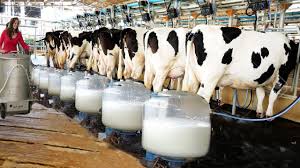This article will cover the milking process on a dairy farm. The milking process is crucial because improper milking methods can lead to injury to the udder, reduce milk yield, and may result in diseases such as mastitis.
Milk is a vital nutrient for humans, containing proteins, calcium, potassium, phosphorus, vitamin A, riboflavin, and thiamine.
Read Also: Earthen Pond Management: Steps to take before putting the Fish in the Water
Management of Milking Cows

Dairy cows are creatures of habit and respond well to routine procedures. Milking is usually performed twice daily early in the morning and late in the afternoon, around 5:30 AM and 3:30 PM. It is possible to milk more than twice a day, and this has been shown to increase milk production, though it requires more labor.
Between the two milking periods, animals are either grazed, fed concentrate in pens, or both. In tropical regions, it is advisable to graze animals in the mornings and evenings due to high ambient temperatures during the day. However, grazing should not begin too early in the morning to prevent bloat, which is caused by cattle consuming excessive grasses or grasses covered with dew. Concentrate feeding of dairy cows is done in relation to their milk production.
Milking Systems
There are two primary milking methods:
1. Hand Milking
This method is commonly used by traditional herdsmen. Hand milking is labor-intensive, time-consuming, inefficient, and can lead to injuries to the milker, as well as a high risk of milk contamination by the cow, herdsman, or external elements such as dust, dirt, and insects. Despite these drawbacks, it is a cost-effective method. Certain cattle breeds, such as Sahiwal, which have large teats that cannot fit into milking cups, are typically hand-milked.
2. Machine Milking

This method is more efficient, allowing large numbers of cows to be milked in a short time. Machine milking is quick, and the milk obtained is cleaner and free of contaminants. However, the machines are expensive to acquire, operate, and maintain. Expert knowledge is required for their operation and upkeep.
Milking Procedure
The milking process typically occurs in an orderly, step-by-step manner as follows:
1. Both the milker’s hands and the equipment should be cleaned and sanitized to prevent contamination by microorganisms.
2. The udder and teats of the cow should be washed with warm water and a sanitizing solution, followed by a gentle massage. It is advisable to use individual napkins or disposable paper towels to clean the udder after washing. Washing the udder stimulates milk ejection and prevents contamination.
3. In cases of hand milking, Vaseline is applied to soften the teats.
4. Whether by hand or machine, the teats should be pressed to check the first few drops of milk for purity. If any clotting, pus, or blood is present, the cow likely has mastitis. Such cows should be milked last, and the milk discarded.
5. If the milk is uncontaminated, milking proceeds either by hand or by attaching the milking machine gently to the teat.
6. After milking, the machine is removed gently as soon as milk flow stops.
7. The teats are then dipped in an antiseptic solution to prevent contamination.
Read Also: The Quantity of Fingerlings/Juveniles to Start your Fish Farm with
Bad Traits in Milking Cows

Several undesirable traits are exhibited by cows during milking. Some are highlighted below:
1. Kicking: Cows may kick during milking due to rough handling, over-milking, or injury. Such cows will not remain calm for milking and may not release their milk. To prevent this, cows should be fed concentrate during milking, and the calf may be allowed near the cow.
2. Milk Leakage: Weak sphincter muscles in the teat can cause milk leakage. Such animals should be culled.
3. Hard Milking: In some cases, the teats may be too hard, making milking difficult, especially by hand. Cows with this trait should be sold.
4. Milk Production Pattern: Well-fed and well-managed dairy cows follow a consistent milk production pattern. Initially, production increases to a peak, stabilizes for a period, and then declines until the cow dries up. This is illustrated in the figure below.
In contrast, improperly fed or poorly managed cows do not exhibit a consistent production pattern. The average peak lactation period for tropical animals is about 30 days, due to poor feeding, watering, high temperatures, and pest and disease attacks.
FAT-Corrected Milk Yield or 305 Days 4% FAT Milk Yield (FCM)
Lactation periods vary between animals, as does the composition of milk. Milk contains water, dry matter, fat, protein, lactose, and minerals in varying amounts, depending on the breed of the cow. The composition in tropical and temperate breeds is shown in the table below.
ComponentTropical (%)Temperate (%)Water87.286.1Fat12.813.9Solid-Not-Fat3.45-6—Protein9.19.3Lactose3.54.9Minerals0.70.7
Standardization of milk yield across different breeds of dairy cows is necessary for the following reasons:
1. To assess the milking ability of a cow.
2. To compare the milking abilities of different cows.
3. To standardize the lactation period.
4. To compare the performance of different daughters of a particular male.
Milk is an essential food, particularly for infants and those recovering from illness. It contains all the amino acids necessary for optimal growth and development. The process of obtaining milk from cows must be carried out under hygienic conditions to ensure its safety and quality.
Do you have any questions, suggestions, or contributions? If so, please feel free to use the comment box below to share your thoughts. We also encourage you to kindly share this information with others who might benefit from it. Since we can’t reach everyone at once, we truly appreciate your help in spreading the word. Thank you so much for your support and for sharing!
Read Also: Palm Fruit: Health Benefits, Facts and Recipes
Frequently Asked Questions
We will update this section soon.

